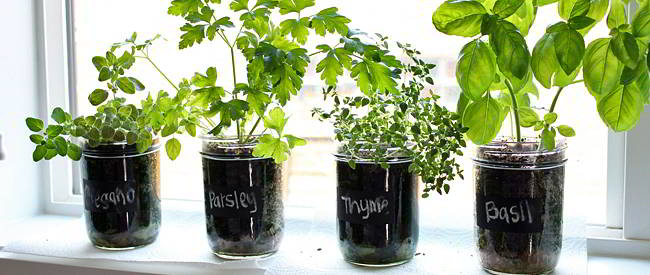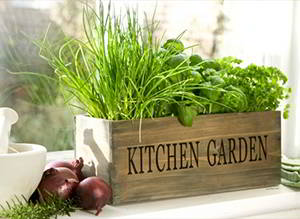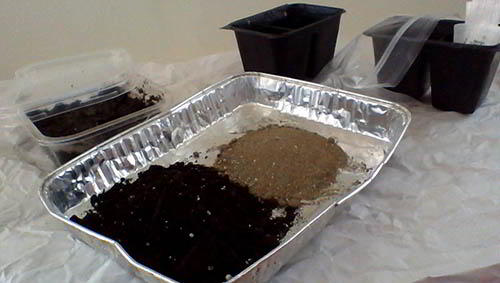How I Grow My Herbs Indoors

by MARY
Fresh herbs should be a priority for every survivalist. They are great for flavoring foods but they are also packed with vitamins and some have medicinal uses. Herbs grow like weeds outdoors in average to sandy garden soil but conditions might not always be conducive to outdoor growing. Animals might eat them, other people may help themselves to them or maybe you just like the convenience of having them indoors. As long as you can provide enough light, growing herbs indoors is easy to do. You can buy seeds and start your own seedlings. That’s why I made The Medicinal Garden Kit, because I wanted to empower other people to take their health into their own hands, just as I did. I think everyone should have a medicinal garden in their backyard. The kit contains ten powerful herbal seed packages( 2,409 high-quality seeds, GMO Free) that can help us provide relief from illness. Moreover, there is no need to worry about how to care for them as the product comes with a detailed instruction manual on how to use these medicinal plants.  You can pick any of these medicinal plants and turn it into the remedy you need. I’ve gathered all the seeds for 10 herbs, inside the Medicinal Garden Kit. All these seeds have been handpicked from the very best plants, as I wanted nothing less than premium quality seeds.
You can pick any of these medicinal plants and turn it into the remedy you need. I’ve gathered all the seeds for 10 herbs, inside the Medicinal Garden Kit. All these seeds have been handpicked from the very best plants, as I wanted nothing less than premium quality seeds.
You can get the kit HERE!
What you will need:
 Seed-starting container (flats, pots or even re-purposed plastic containers)
Seed-starting container (flats, pots or even re-purposed plastic containers)- Houseplant potting soil (average garden soil does not drain quickly enough for container plants)
- Coarse builder’s sand or vermiculite
- Herb seeds
- Pots with drain holes in the bottom
- Fluorescent lights for low-light conditions
- 24-hour plug-in timer
How to start seeds:
- Prepare the container. Soak used containers in disinfectant for 10 minutes after washing them with hot, soapy water. Soak new, porous terra cotta or clay pots in fresh, clean water for 6 to 8 hours so that they don’t suck the moisture out of the seed-starting mix.
- Mix course builder’s sand or vermiculite with houseplant potting soil for a half and half mixture.
- Pour the seed-starting mix into the container. It should be about 2 inches deep.
- Moisten the mix with water. Use distilled water or tap water that has been aged for 24 hours in an open container.
- Sow the seeds 2 to 4 inches apart in the pre-moistened mix. Planting depth varies, depending on the herb. Most should be covered with no more than 1/4 inch of mix.

My Sow Seeds
- Put the container in a zipper-close, clear plastic bag and seal it shut or seal the container with a lid. Use a clear lid so you can easily see the new sprouts. Set the container in bright, indirect light.
- Check the mix daily. Spray it with aged or distilled water from a spray bottle if it begins to dry. The seeds must be kept moist and warm. About 75 degrees F. or 24 degrees C. is best.
- Remove the cover as soon as you see the little green sprouts emerging. Set the container where they will get 1 to 2 hours of direct sunlight after the sprouts are about 1/2 inch tall.
- Continue to keep them moist and warm.
How to Care for Herbs Indoors:
The biggest challenge you will face when growing herbs indoors will be providing enough light. Outdoor light is much brighter than indoor light. Windows that face south will give herbs plenty of light and they might do fine with a western exposure. Windows that face east will not provide enough natural sunlight and, of course, windows that face north provide no direct sunlight at all. Herbs growing in an eastern or northern exposure will have to get supplemental light. Otherwise, they will grow slowly, if at all, and become pale and spindly. There’s no need for concern, though, if you only have an eastern or northern window. As long as you have full-spectrum fluorescent lights and electricity, you can give your herbs the light they need.
- Pot up the new herb seedlings as soon as they are big enough to handle or when they are 2 to 4 inches tall. Each herb should have a 4- to 6-inch diameter pot or you can put multiple plants in larger containers.
- Pour 1 to 2 inches of houseplant potting soil into containers with drain holes. Most herbs grow best in a mix consisting of 2/3 to 3/4 potting soil and 1/3 to 1/4 vermiculite or coarse builder’s sand.
- Gently work the seedlings up out of the seed-starting mix. Use a small spoon or butter knife to push them up out of the soil. Handle them gently by the rootball. Do not try to pick them up by the stem.
- Set each seedling in its new container and gently hold the stem upright while you fill in around the roots with more potting soil.
- Water newly planted herbs until the water drains from the drain hole in the bottom of the pot. Water carefully, though, so you don’t wash the plant right up out of the soil.
- Set the newly-potted herbs where they will get 1 to 2 hours of direct sunlight. Increase the direct sunlight exposure by 1 to 2 hours every few days to gradually get them used to at least 6 hours of direct sunlight.
If you are growing herbs in an eastern or northern window, set up fluorescent lights so they are 4 to 6 inches above the plants. Use a 2- to 4-bulb fixture with a reflector hood. You can use 1 to 2 full-spectrum plant grow bulbs and 1 to 2 cool-white 20- to 40-watt bulbs. The cool white bulbs are cheaper. Make sure the lamp fixture is adjustable so you can raise the bulbs as the herbs grow.
Plug the fluorescent light fixture into a 24-hour timer. Set the timer to turn the lights on around sunrise. The lights must remain on as follows:
- 12 to 14 hours for plants in an east-facing window.
- 16 to 18 hours for plants in a north-facing window.
Monitor herbs growing in front of a west-facing window. If they seem to grow slowly or become pale and spindly, set up fluorescent lights and set the timer so they stay on for 12 to 14 hours each day.
Remember, the fluorescent light is meant to supplement natural light. It is important to maintain the day/night schedule so the herbs get 8 to 10 hours of dark at night. Newly-potted seedlings can be set beneath the fluorescent lights right away but start out with the lights suspended 8 to 10 inches above them so they are not overwhelmed.

My Indoor Garden: Parsley, Oregano and Rosemary
Water and Fertilizer
Rule of thumb is – water when the top inch of potting soil becomes dry. However, some herbs like their soil to stay moist while others prefer dryer conditions. Rosemary, oregano and parsley, for example, grow best when the potting soil is kept uniformly moist. Water them when the top of the potting soil just begins to dry. Basil, on the other hand, grows best if it is kept a little dryer. You can let the top 1 to 2 inches of potting soil become dry before watering basil. Pour the water evenly over the soil until it begins to drain from the bottom of the pot.
Use water that has been “aged” or left in an open container for 24 hours, if you are using tap water. This allows the chlorine to dissipate. You can also use rain water or distilled water and should do so if your tap water is high in sodium. Lots of water purification systems will cause tap water to have high sodium levels. Just reducing the sodium levels by mixing tap with distilled or rain water may be enough. If the potting soil develops a white residue, sodium levels are too high. Either repot the herbs in fresh potting soil or drench the existing soil with rain or distilled water to remove the excess sodium.
Feed herbs with fertilizer diluted to half strength. A balanced fertilizer ratio of 10-10-10 is good for most herbs, although some, like basil, prefer a high-nitrogen fertilizer. High-nitrogen fertilizer will have a higher number listed first in the ratio listing. For example, fertilizer with a ratio of 10-3-3 is a high-nitrogen fertilizer.
Give the herbs fertilizer every third or fourth watering. Always give them fertilizer right after a regular watering. Never give herbs fertilizer before watering them.
Unfortunately, I can’t cover all plants in one article. Plus I wanted to add larger photos. So I decided to put all the information in one book that covers more than 800 plants, with photos, across the U.S. It’s called ”The Lost Book Of Herbal Remedies” Written in collaboration with my friend Dr. Nicole Apelian, who is a mother, a naturalist, a trainer in survival skills, and a Ph.D. holder. Her undergraduate education was in Biology at McGill University, and she continued her herbal studies. Her life was spent among one of the most ancient cultures of the world, the San Bushmen. For the past 20 years, Dr. Nicole has been dealing with her Multiple sclerosis by using natural remedies and medicinal plants she grows in her backyard. She has also survived 57 days all alone in the wild, which was later featured on a history TV channel. Her journey from a wheelchair to living the fullest life. Whenever she has any health issue like headache, body pain, fever, or infection, she turns towards her little backyard pharmacy. You can get your hardtop copy of the book HERE!
Anyone can join.
Anyone can contribute.
Anyone can become informed about their world.
"United We Stand" Click Here To Create Your Personal Citizen Journalist Account Today, Be Sure To Invite Your Friends.
Humic & Fulvic Liquid Trace Mineral Complex
HerbAnomic’s Humic and Fulvic Liquid Trace Mineral Complex is a revolutionary New Humic and Fulvic Acid Complex designed to support your body at the cellular level. Our product has been thoroughly tested by an ISO/IEC Certified Lab for toxins and Heavy metals as well as for trace mineral content. We KNOW we have NO lead, arsenic, mercury, aluminum etc. in our Formula. This Humic & Fulvic Liquid Trace Mineral complex has high trace levels of naturally occurring Humic and Fulvic Acids as well as high trace levels of Zinc, Iron, Magnesium, Molybdenum, Potassium and more. There is a wide range of up to 70 trace minerals which occur naturally in our Complex at varying levels. We Choose to list the 8 substances which occur in higher trace levels on our supplement panel. We don’t claim a high number of minerals as other Humic and Fulvic Supplements do and leave you to guess which elements you’ll be getting. Order Your Humic Fulvic for Your Family by Clicking on this Link , or the Banner Below.
Our Formula is an exceptional value compared to other Humic Fulvic Minerals because...
It’s OXYGENATED
It Always Tests at 9.5+ pH
Preservative and Chemical Free
Allergen Free
Comes From a Pure, Unpolluted, Organic Source
Is an Excellent Source for Trace Minerals
Is From Whole, Prehisoric Plant Based Origin Material With Ionic Minerals and Constituents
Highly Conductive/Full of Extra Electrons
Is a Full Spectrum Complex
Our Humic and Fulvic Liquid Trace Mineral Complex has Minerals, Amino Acids, Poly Electrolytes, Phytochemicals, Polyphenols, Bioflavonoids and Trace Vitamins included with the Humic and Fulvic Acid. Our Source material is high in these constituents, where other manufacturers use inferior materials.
Try Our Humic and Fulvic Liquid Trace Mineral Complex today. Order Yours Today by Following This Link.







